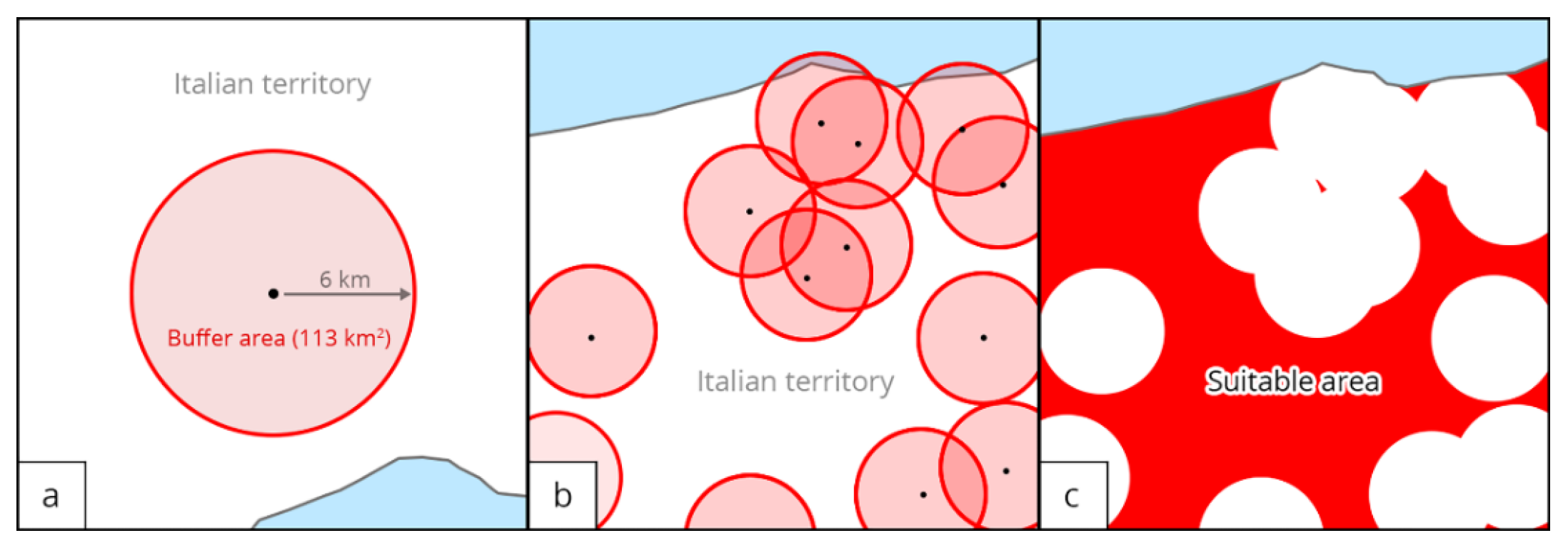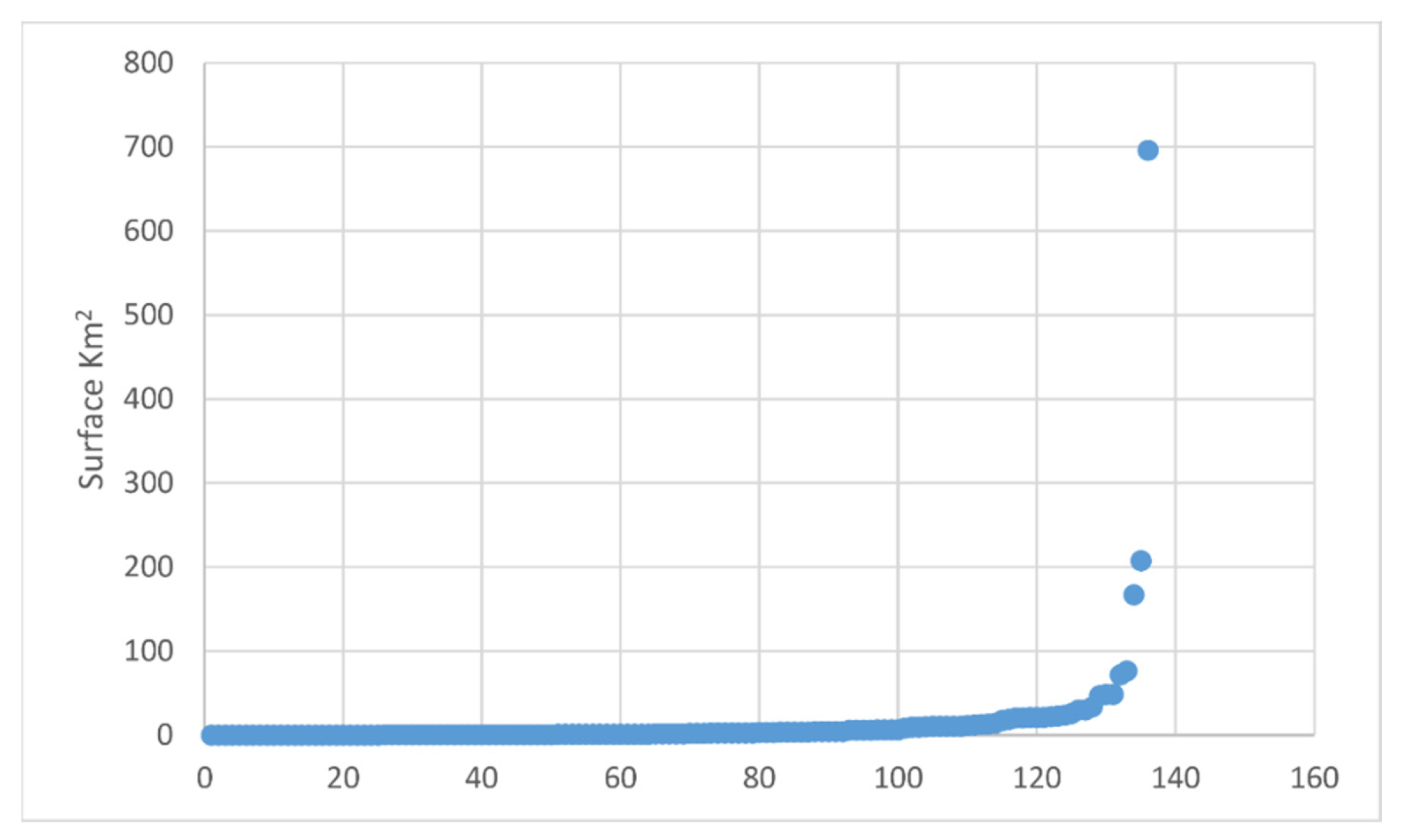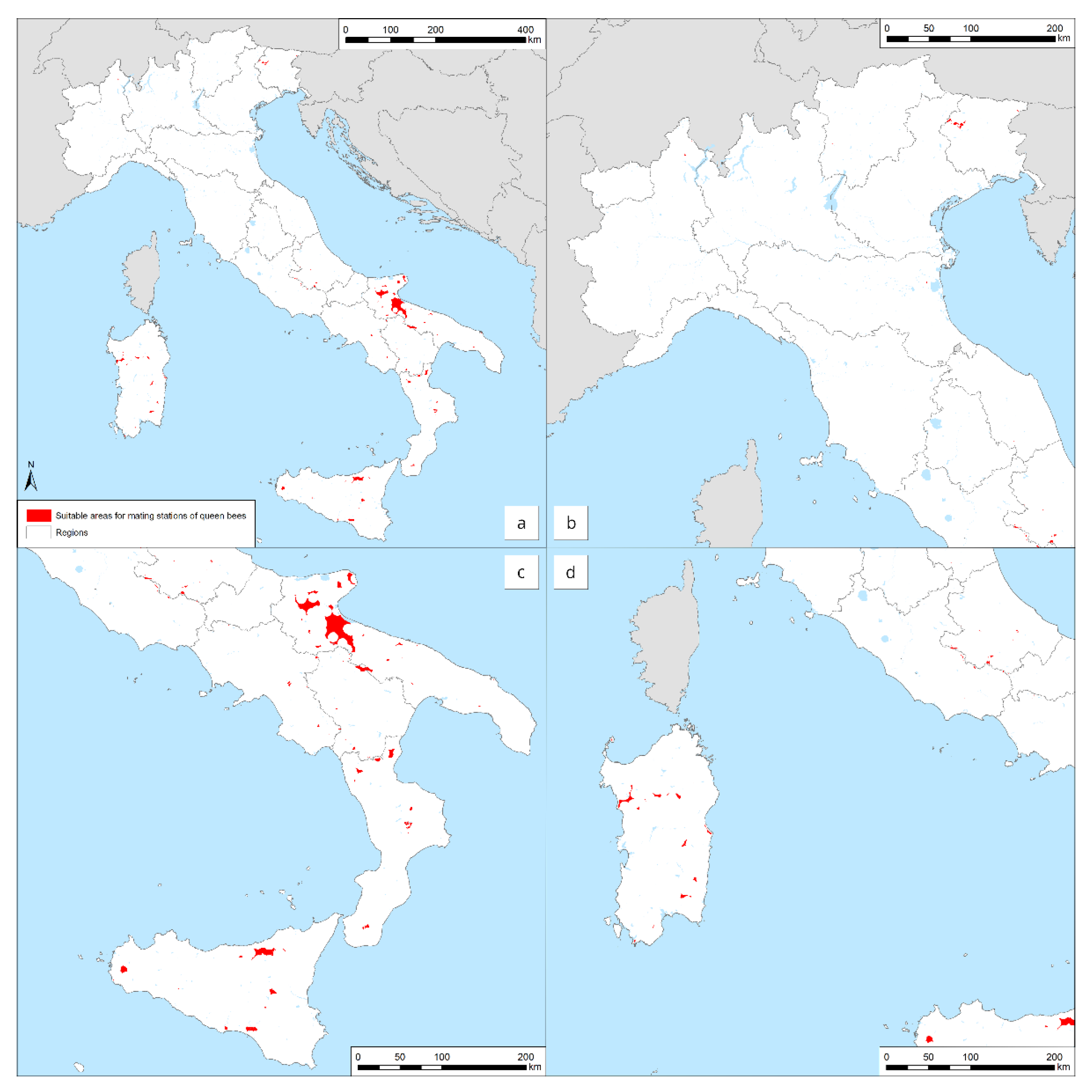The Italian National Beekeeping Registry (BDNA) as a Tool to Identify Areas Suitable for Controlled Mating of Honey Bees in Italy
Abstract
1. Introduction
- -
- economic-sanitary protection and improvement of the bee heritage, food safety, and pharmaco-surveillance;
- -
- monitoring of the movements of the hives;
- -
- protection and safeguard of the environment and the ecosystem.
2. Materials and Methods
- -
- distance of at least 6000 m from an apiary;
- -
- not be classified as wetlands;
- -
- altitude below 1500 m above sea level (a.s.l.);
- -
- distance of at least 1500 m from the national terrestrial border.
- (1)
- collection of the required data (i.e., apiaries coordinates, geospatial data on soil classification, geospatial data on terrain altitude, Italian boundary geospatial data);
- (2)
- calculation for the excluded areas (i.e., areas within the distance of 6000 m from every apiaries, areas classified as wetland, areas which altitude is above 1500 m, areas within the distance of 1500 m from the Italian boundary);
- (3)
- calculation of the mating areas by means of the difference between the entire Italian territory and the excluded areas.
2.1. Collection of the Required Data
2.2. Calculation for the Excluded Areas
3. Results
4. Discussion
Author Contributions
Funding
Institutional Review Board Statement
Informed Consent Statement
Data Availability Statement
Conflicts of Interest
References
- Peer, D.F. Further studies on the mating range of the honey bee, Apis mellifera L. Can. Entomol. 1957, 89, 108–110. [Google Scholar] [CrossRef]
- Zmarlicki, C.; Morse, R.A. Drone congregation areas. J. Apic. Res. 1963, 2, 64–66. [Google Scholar] [CrossRef]
- Crane, E. Bees and Beekeeping—Science, Practice and World Resources; Heinemann Newnes: Oxford, UK, 1990; pp. 77–79. [Google Scholar]
- Königer, N.; Königer, G. Mating flight duration of Apis mellifera queens: As short as possible, as long as necessary. Apidologie 2007, 38, 606–611. [Google Scholar] [CrossRef]
- Büchler, R.; Andonov, S.; Bienefeld, K.; Costa, C.; Hatjina, F.; Kezic, N.; Kryger, P.; Spivak, M.; Uzunov, A.; Wilde, J. Standard methods for rearing and selection of Apis mellifera queens. J. Apic. Res. 2013, 52. [Google Scholar] [CrossRef]
- Tiesler, F.K.; Englert, E. Aufzucht, Paarung und Verwertung von Königinnen; Ehrenwirth Verlag: München, Germany, 1989. [Google Scholar]
- Decreto 4 dicembre 2009. Disposizioni per L’anagrafe Apistica Nazionale. [Decree 4 December 2009. Provisions for the National Beekeeping Registry]. GURI, n. 93. 22 April 2010. Available online: https://www.gazzettaufficiale.it/eli/gu/2010/04/22/93/sg/pdf (accessed on 8 January 2021).
- Ministero Della Salute. Approvazione del Manuale Operativo per la Gestione Dell’anagrafe Apistica Nazionale, in Attuazione Dell’articolo 5 del Decreto 4 Dicembre 2009, Recante: “Disposizioni per L’Anagrafe Apistica Nazionale”. [D. M. 11 August 2014. Approval of the Operating Manual for the Management of the National Beekeeping Registry, in Implementation of Article 5 of the Decree of 4 December 2009]. GURI, n. 291. 16 December 2014. Available online: https://www.gazzettaufficiale.it/eli/id/2014/12/16/14A09510/sg (accessed on 8 January 2021).
- Decreto Interdirettoriale 22 November 2017 Della Direzione Generale Della Sanità Animale e dei Farmaci Veterinari del Ministero Della Salute e Della Direzione Generale Dello Sviluppo Rurale del Ministero Delle Politiche Agricole, Alimentari e Forestali [Interdirectoral Decree 22 November 2017 of the Directorate General for Animal Health and Veterinary Medicines of the Ministry of Health and the Directorate General of Rural Development of the Ministry of Agricultural, Food and Forestry Policies] (0027115-27/11/2017-DGSAF-MDS-P). 2017. Available online: https://www.trovanorme.salute.gov.it/norme/renderNormsanPdf?anno=2017&codLeg=62419&parte=1%20&serie=null (accessed on 8 January 2021).
- Decreto del Ministero Delle Politiche Agricole Alimentari e Forestali n. 1839 del 30 Gennaio 2013 che Approva il Regolamento dell’Albo Nazionale Degli Allevatori Api Italiane e il Relativo Disciplinare Tecnico. [Decree of the Ministry of Agricultural, Food and Forestry Policies no. 1839 of 30 January 2013 approving the Regulation of the National Registry of Italian Bee Breeders and related technical standards]. 2013. Available online: https://www.crea.gov.it/documents/71515/0/Api_it_disciplinare.pdf/a9063372-a0d0-3b84-ee42-9efa405695a3?t=1579185596323 (accessed on 8 January 2021).
- Legge Regionale 4 Marzo 2019, n. 2. Norme per lo sviluppo, l’esercizio e la Tutela dell’apicoltura in Emilia-Romagna. Abrogazione Della Legge Regionale 25 Agosto 1988, n. 35 e dei Regolamenti Regionali 15 Novembre 1991, n. 29 e 5 Aprile 1995, n. 18. [Regional Law 4 March 2019, n. 2. Rules for the Development, Functioning and Protection of Apiculture in Emilia-Romagna. Repeal of the Regional law 25 August 1988, No. 35 and of the Regional Regulations 15 November 1991, No. 29 and 5 April 1995, No. 18]. GURI, 3a Serie Speciale—Regioni n. 22. 1 June 2019. Available online: https://www.gazzettaufficiale.it/eli/id/2019/06/01/19R00148/S3#:~:text=La%20Regione%20Emilia%2DRomagna%20riconosce,sviluppo%20dell’agricoltura%20in%20generale (accessed on 8 January 2021).
- Wilson, J.P. Local, national, and global applications of GIS in agriculture. In Geographical Information Systems: Principles, Techniques, Management, and Applications, 2nd ed.; Longley, P.A., Goodchild, M.F., Maguire, D.J., Rhind, D.W., Eds.; John Wiley and Sons: New York, NY, USA, 1999; pp. 981–998. [Google Scholar]
- EFSA Panel on Animal Health and Welfare (AHAW). Assessing the health status of managed honey bee colonies (HEALTHY-B): A toolbox to facilitate harmonised data collection. EFSA J. 2016, 14, 4578. [Google Scholar] [CrossRef]
- Rogers, S.R.; Staub, B. Standard use of Geographic Information System (GIS) techniques in honey bee research. J. Apic. Res. 2013, 52. [Google Scholar] [CrossRef]
- Abou-Shaara, H.F. Geographical Information System for beekeeping development. J. Apic. Sci. 2019, 63, 5–16. [Google Scholar] [CrossRef]
- Camargo, S.C.; Garcia, R.C.; Feiden, A.; De Vasconcelos, E.S.; Pires, B.C.; Hartleben, A.M.; De Moraes, F.J.; De Oliveira, L.; Giasson, J.; Mittanck, E.S.; et al. Implementation of a geographic information system (GIS) for the planning of beekeeping in the west region of Paraná. An. Acad. Bras. Ciênc. 2014, 86, 955–971. [Google Scholar] [CrossRef] [PubMed]
- Zoccali, P.; Malacrinò, A.; Campolo, O.; Laudani, F.; Algeri, G.M.; Giunti, G.; Strano, C.P.; Benelli, G.; Palmeri, V. A novel GIS-based approach to assess beekeeping suitability of Mediterranean lands. Saudi J. Biol. Sci. 2017, 24, 1045–1050. [Google Scholar] [CrossRef] [PubMed]
- Cobey, S.W.; Tarpy, D.R.; Woyke, J. Standard methods for instrumental insemination of Apis mellifera queens. J. Apic. Res. 2013, 52. [Google Scholar] [CrossRef]





Publisher’s Note: MDPI stays neutral with regard to jurisdictional claims in published maps and institutional affiliations. |
© 2021 by the authors. Licensee MDPI, Basel, Switzerland. This article is an open access article distributed under the terms and conditions of the Creative Commons Attribution (CC BY) license (https://creativecommons.org/licenses/by/4.0/).
Share and Cite
Mutinelli, F.; Mazzucato, M.; Barbujani, M.; Carpana, E.; Di Salvo, V.; Gardi, T.; Greco, D.; Bonizzoni, L.; Benvenuti, M.; Casarotto, C.; et al. The Italian National Beekeeping Registry (BDNA) as a Tool to Identify Areas Suitable for Controlled Mating of Honey Bees in Italy. Appl. Sci. 2021, 11, 5279. https://doi.org/10.3390/app11115279
Mutinelli F, Mazzucato M, Barbujani M, Carpana E, Di Salvo V, Gardi T, Greco D, Bonizzoni L, Benvenuti M, Casarotto C, et al. The Italian National Beekeeping Registry (BDNA) as a Tool to Identify Areas Suitable for Controlled Mating of Honey Bees in Italy. Applied Sciences. 2021; 11(11):5279. https://doi.org/10.3390/app11115279
Chicago/Turabian StyleMutinelli, Franco, Matteo Mazzucato, Marco Barbujani, Emanuele Carpana, Vincenzo Di Salvo, Tiziano Gardi, Daniele Greco, Luca Bonizzoni, Massimo Benvenuti, Claudia Casarotto, and et al. 2021. "The Italian National Beekeeping Registry (BDNA) as a Tool to Identify Areas Suitable for Controlled Mating of Honey Bees in Italy" Applied Sciences 11, no. 11: 5279. https://doi.org/10.3390/app11115279
APA StyleMutinelli, F., Mazzucato, M., Barbujani, M., Carpana, E., Di Salvo, V., Gardi, T., Greco, D., Bonizzoni, L., Benvenuti, M., Casarotto, C., Bortolotti, L., & Costa, C. (2021). The Italian National Beekeeping Registry (BDNA) as a Tool to Identify Areas Suitable for Controlled Mating of Honey Bees in Italy. Applied Sciences, 11(11), 5279. https://doi.org/10.3390/app11115279







